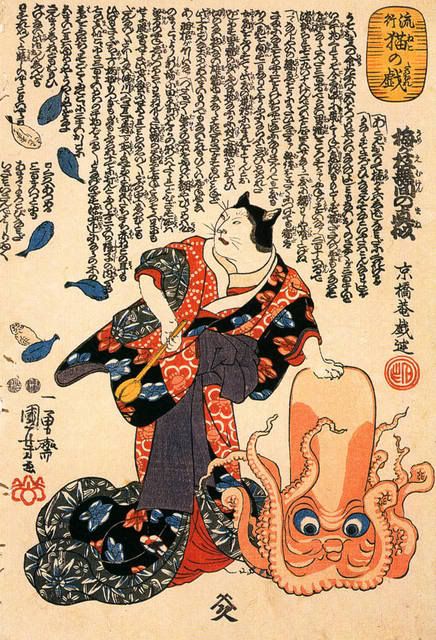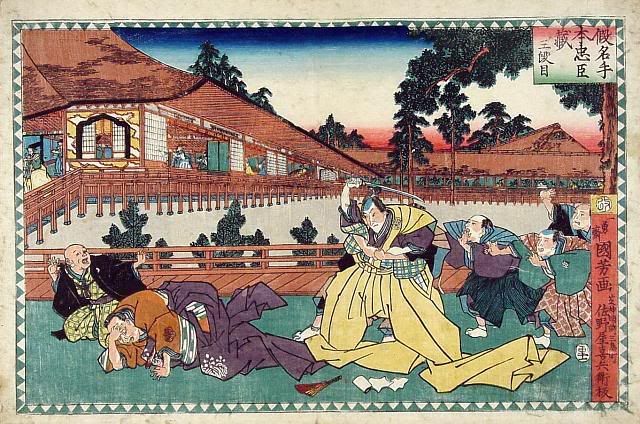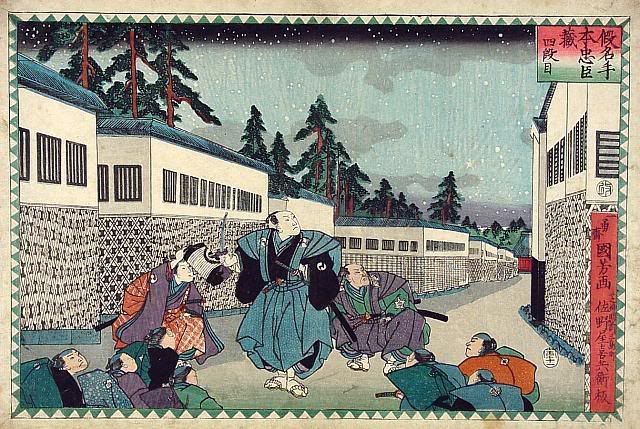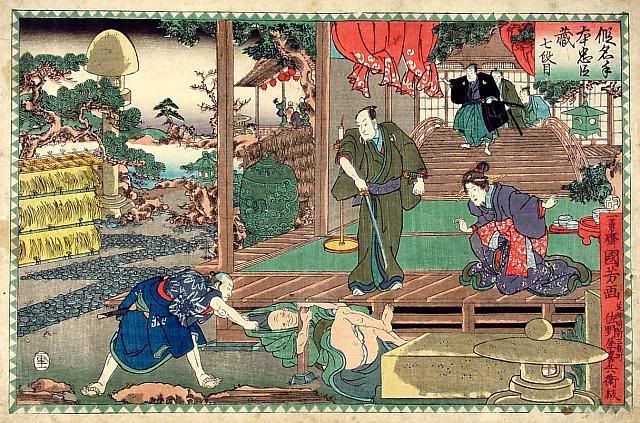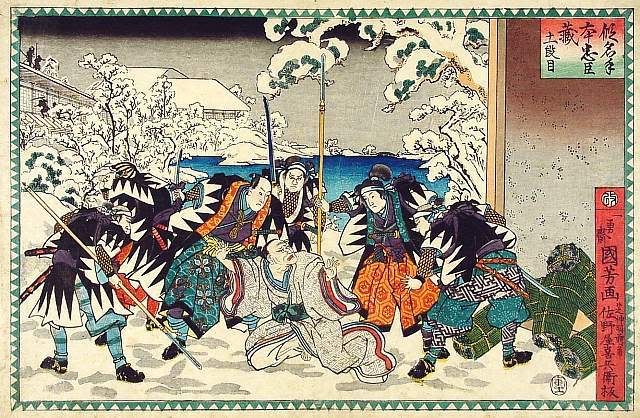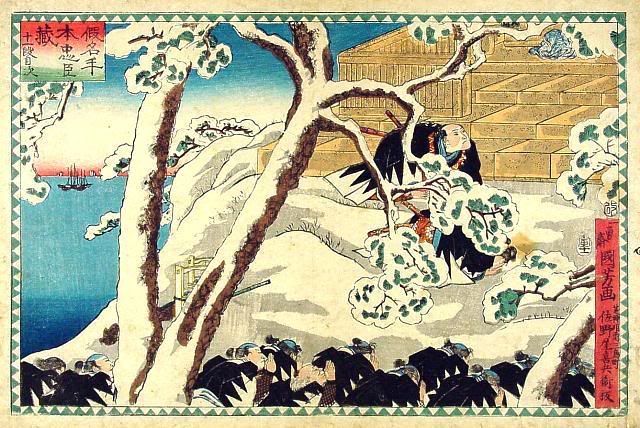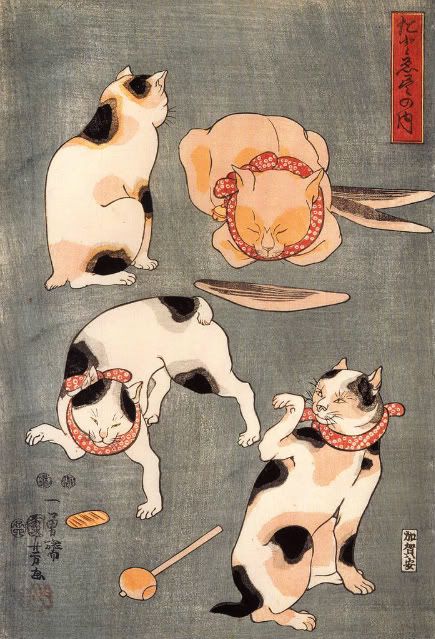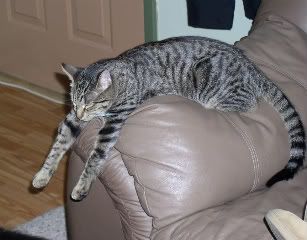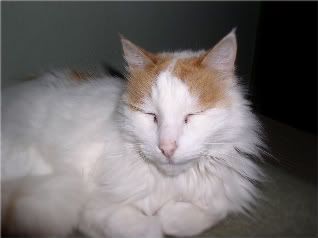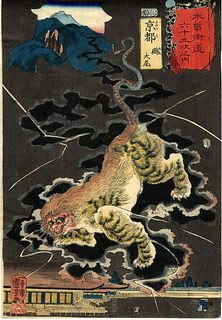Kuniyoshi's most famous works focused on folk heroes and placed them within the context of his time. Many of his heroes are placed in his art within the mythological perspective, as the stories were told about them many years after they walked the Earth. In one of the paintings below we will see Musashi killing a Nue, which is a mythological creature. (see prior post about the Nue, http://kuniyoshicat.blogspot.com/2008/02/nue-from-wikipedia-free-encyclopedia.html)
Click the title above to see the entire entry about Musashi, posted at Wikipedia. Here is an excerpt:
Miyamoto Musashi (宮本 武蔵, Miyamoto Musashi?) (c. 1584–June 13 (Japanese calendar: May 19), 1645), also known as Shinmen Takezō, Miyamoto Bennosuke, or by his Buddhist name Niten Dōraku[1], was a Japanese swordsman famed for his duels and distinctive style. Musashi, as he is often simply known, became legendary through his outstanding swordsmanship in numerous duels, even from a very young age. He is the founder of the Hyōhō Niten Ichi-ryū or Niten-ryū style of swordsmanship and the author of The Book of Five Rings (五輪書, Go Rin No Sho?), a book on strategy, tactics, and philosophy that is still studied today.
First duel
I have trained in the way of strategy since my youth, and at the age of thirteen I fought a duel for the first time. My opponent was called Arima Kihei, a sword adept of the Shinto ryu, and I defeated him. At the age of sixteen I defeated a powerful adept by the name of Akiyama, who came from the province of Tajima. At the age of twenty-one I went up to Kyoto and fought duels with several adepts of the sword from famous schools, but I never lost.
—Miyamoto Musashi, Go Rin No Sho
According to the introduction of The Book of Five Rings, Musashi states that his first successful duel was at the age of thirteen, against a samurai named Arima Kihei who fought using the Kashima Shintō-ryū style, founded by Tsukahara Bokuden (b. 1489, d. 1571). The main source of the duel is the Hyoho senshi denki ("Anecdotes about the Deceased Master"). Summarized, its account goes as follows:
In 1596, Musashi was 13, and Arima Kihei, who was traveling to hone his art, posted a public challenge in Hirafuku-mura. Musashi wrote his name on the challenge. A messenger came to Dorin's temple, where Musashi was staying, to inform Musashi that his duel had been accepted by Kihei. Dorin, Musashi's uncle, was shocked by this, and tried to beg off the duel in Musashi's name, based on his nephew's age. Kihei was adamant that the only way his honor could be cleared was if Musashi apologized to him when the duel was scheduled. So when the time set for the duel arrived, Dorin began apologizing for Musashi, who merely charged at Kihei with a six-foot quarterstaff, shouting a challenge to Kihei. Kihei attacked with a wakizashi, but Musashi threw Kihei on the floor, and while Kihei tried to get up, Musashi struck Arima between the eyes and then beat him to death. Arima was said to have been arrogant, overly eager to fight, and not a terribly talented swordsman.
—William Scott Wilson, The Lone Samurai[10]
The duel is odd for a number of reasons, not least of which is why Musashi was permitted to duel Arima, whether the apology was a ruse, and why Arima was there in the first place.
Way of strategy
Throughout the book, Go Rin No Sho, the idea which Musashi pushes is that the "way of the strategist" (Heihō 兵法) is similar to how a carpenter and his tools are mutually inclusive, e.g. - A carpenter can do nothing without his tools, and vice versa. This too, he compares to skill, and tactical ability in the field of battle.
Musashi's metaphor for Strategy is that of the Bulb and the flower, similar to western philosophy of "The chicken or the egg", the "bulb" being the student, the "flower" being the technique. He also notes that most places seem to be mostly concerned with their technique and its beauty. Musashi writes, "In this kind of Way of strategy, both those teaching and those learning the way are concerned with coloring and showing off their technique, trying to hasten the bloom of the flower" (as opposed to the actual harmony between strategy and Skill.)
With those who are concerned with becoming masters of strategy, Musashi points out that as a carpenter becomes better with his tools and is able to craft things with more expert measure, so too can a warrior, or strategist become more skilled in his technique. However, just as a carpenter needs to be able to use his tools according to plans, so too must a strategist be able to adapt his style or technique to the required strategy of the battle he is currently engaged in.
Musashi as an artist
In his later years, Musashi claimed in his Go Rin No Sho that "When I apply the principle of strategy to the ways of different arts and crafts, I no longer have need for a teacher in any domain." He proved this by creating recognized masterpieces of calligraphy and classic ink painting. His paintings are characterized by skilled use of ink washes and an economy of brush stroke. He especially mastered the "broken ink" school of landscapes, applying it to other subjects, such as his "Koboku meikakuzu" ("Kingfisher Perched on a Withered Branch"; part of a triptych whose other two members were "Hotei Walking" and "Sparrow on Bamboo"), his "Hotei Watching a Cockfight", and his "Rozanzu" ("Wild Geese Among Reeds").
Musashi Killing a Nue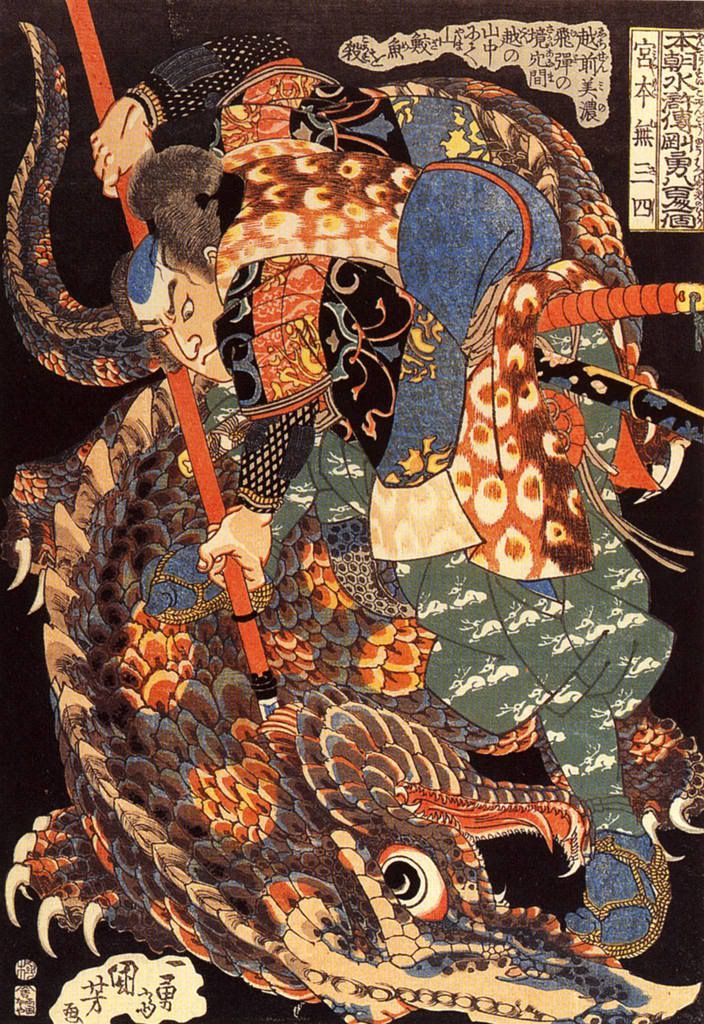
Musashi having his fortune told by a fortune-teller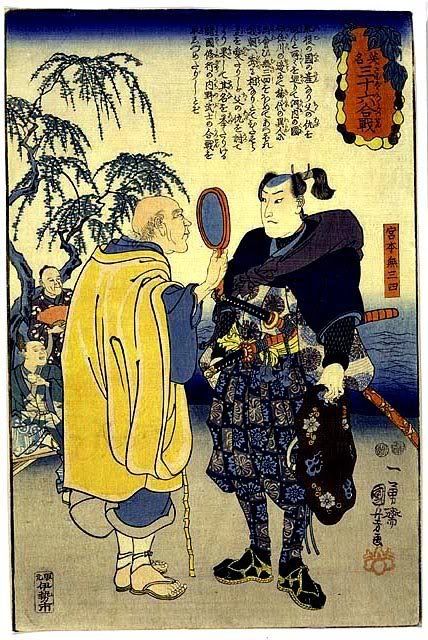
Thursday, July 17, 2008
Miyamoto Musashi: famed Japanese swordsman
Thursday, June 19, 2008
Very Busy
While I am not disappointing very many people right now (few subscribers) I thought I would make an excuse for not having posted in a month.
I have been very busy.
Enjoy a print for now and I'll add more content soon!
Roshi Ensei Lifting a Heavy Beam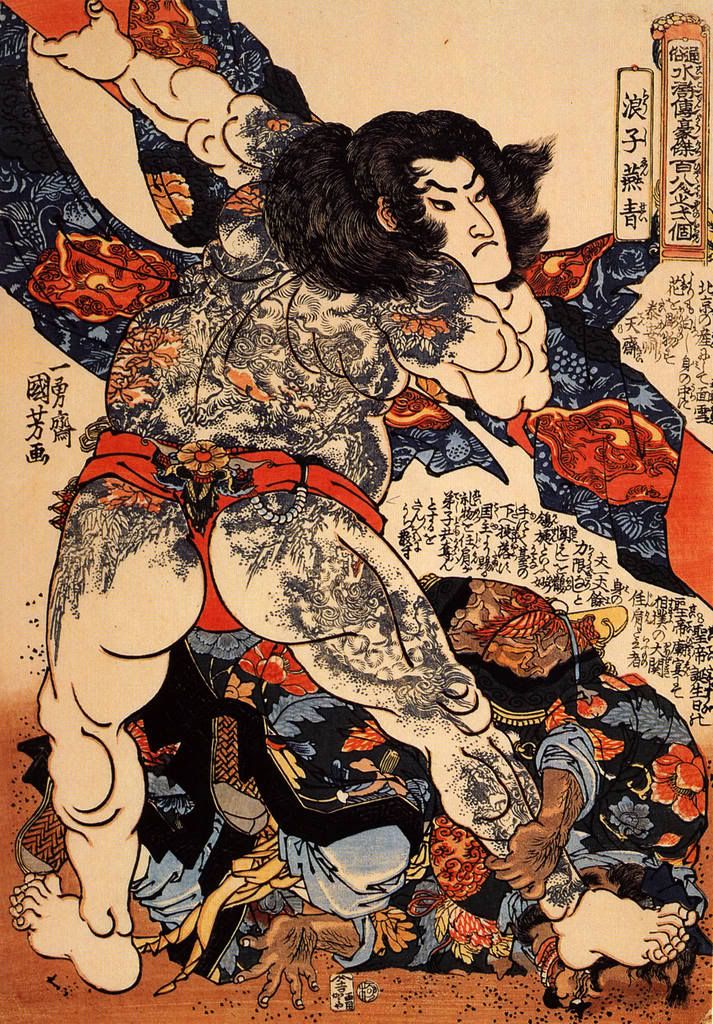
Monday, May 12, 2008
Kuniyoshi T-Shirts
A few shirts, cups, and prints are available through CafePress with many options to choose from. Just click the picture to go to the shop...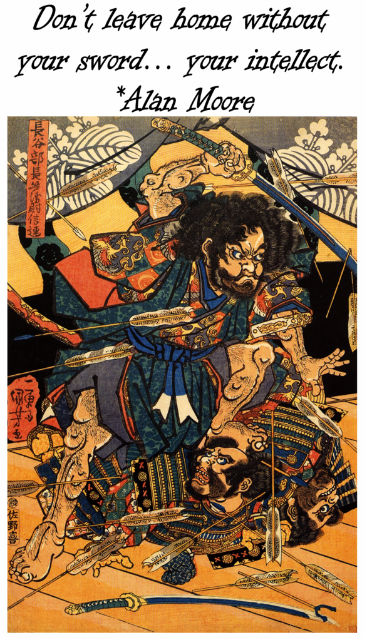
More to come...
Monday, April 28, 2008
Emperor Sutoku and Tengu
歌川国芳
From "A Hundred Verses from Old Japan"
(The Hyakunin-isshu)
translated by William N. Porter
[1909]
THE RETIRED EMPEROR SUTOKU
SUTOKU IN
Se wo hayami
Iwa ni sekaruru
Taki-gawa no
Warete mo sue ni
Awan to zo omou.
THE rock divides the stream in two,
And both with might and main
Go tumbling down the waterfall;
But well I know the twain
Will soon unite again.
Alt. Translation:
Though a swift stream is
Divided by a boulder
In its headlong flow,
Though divided, on it rushes,
And at last unites again.
The town of Kamakura, where is the great bronze image of Buddha Amida, was built by this Emperor, who reigned A.D. 1124-1141; he was then forced by his father, the ex-Emperor Toba, to abdicate in favour of his brother, the Emperor Konoye; afterwards he entered the church, and died in the year 1164, an exile in the Province of Sanuki. This verse is intended to suggest the parting of two lovers, who will eventually meet again.
Legend - from http://en.wikipedia.org/wiki/Emperor_Sutoku
After Sotoku's abdication and exile, he devoted himself to monastic life. He copied numerous scriptures and offered them to the court. Fearing that the scriptures were cursed, the court refused to accept them. Snubbed, Sotoku was said to have resented the court and, upon his death, became an Onryō (Japanese ghost who is able to return to the physical world in order to seek vengeance). Everything from the subsequent fall in fortune of the Imperial court, the rise of the samurai powers, draughts and internal unrests were blamed on his haunting.
Alternatively, he was said to have transformed into an Ootengu, one of the greater tengu (***see definition below), whom, along with the nine-tailed kitsune of Tamamo-no-Mae and the oni Shuten Dōji, are often called the three greatest yōkai (creatures in Japanese folklore ranging from the evil to the mischievous and possess part animal and part human features) of Japan.
Kuniyoshi Print
This selection is from one hundred prints illustrating the Japanese poetry anthology called the Hyakunin Isshu, which was compiled by the poet Fujiwara no Teika 1162-1241 . The Hyakunin Isshu has always been a popular subject, and part of the Japanese culture; it has even taken the form of a card game. This print illustrates the wrath of Emperor Sutoku causing a thunderstorm in Sanuki.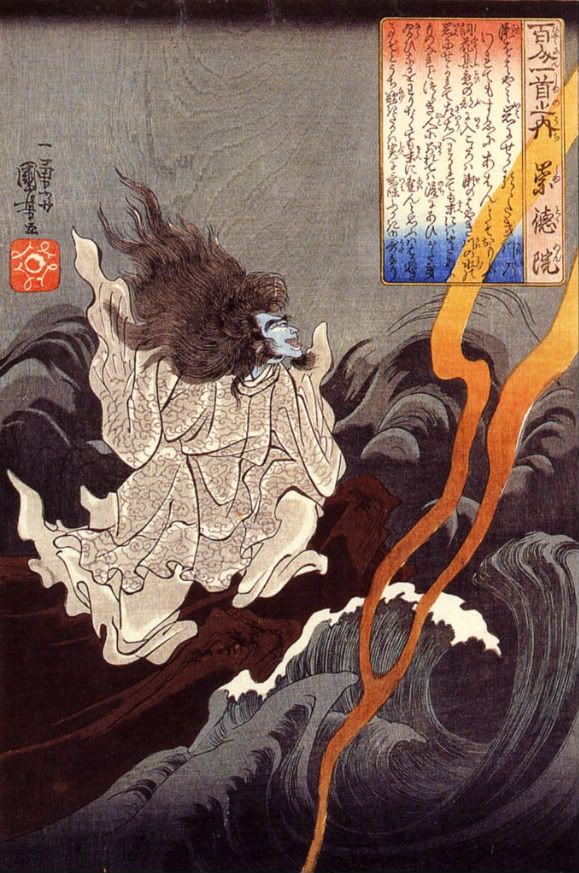
***Tengu - http://en.wikipedia.org/wiki/Tengu
Tengu (天狗, Tengu? "heavenly dogs") are a class of supernatural creatures found in Japanese folklore, art, theater, and literature. They are one of the best known yōkai (monster-spirits) and are sometimes worshipped as Shinto kami (revered spirits or gods). Although they take their name from a dog-like Chinese demon (Tiangou), the tengu were originally thought to take the forms of birds of prey, and they are traditionally depicted with both human and avian characteristics. The earliest tengu were pictured with beaks, but this feature has often been humanized as an unnaturally long nose, which today is practically the tengu's defining characteristic in the popular imagination.
Buddhism long held that the tengu were disruptive demons and harbingers of war. Their image gradually softened, however, into one of protective, if still dangerous, spirits of the mountains and forests. Tengu are associated with the ascetic practice known as Shugendō, and they are usually depicted in the distinctive garb of its followers, the yamabushi.
Elephant catching a flying tengu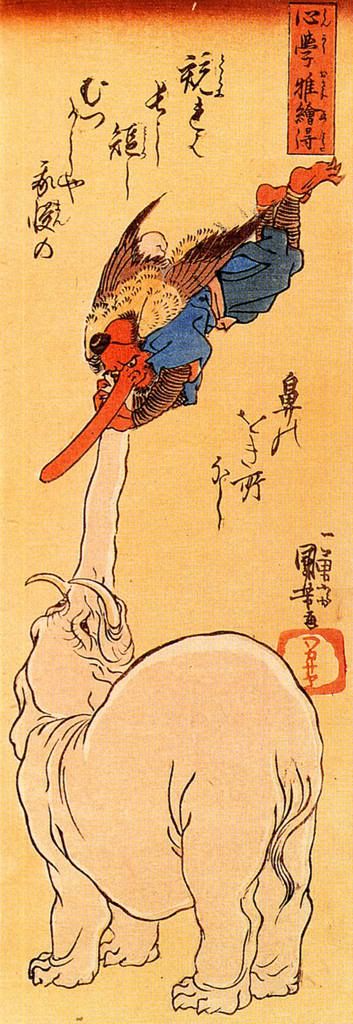
From U. Kuniyoshi's student:
Tsukioka Yoshitoshi, Mount Yoshino Midnight Moon, 1886. From the 100 Phases of the Moon series. 9.25" x 13.5". From here.
Iga no Tsubone confronts the tormented spirit of Sasaki no Kiyotaka, who was forced to comit suicide for giving the emperor bad advice. Sasaki's ghost appears as a troublesome tengu demon, with kite's wings and claws.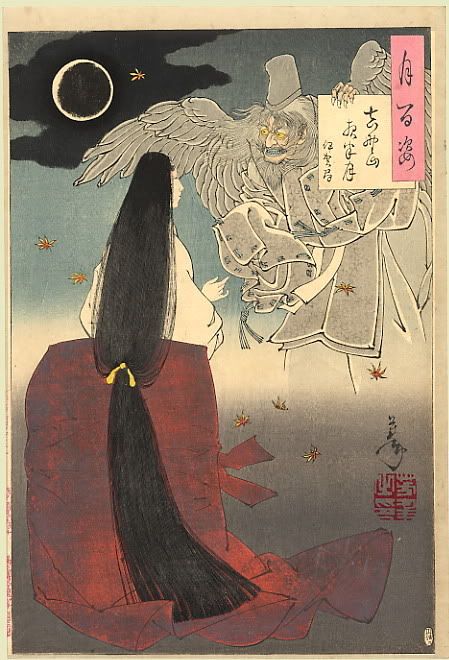
Friday, April 25, 2008
Kuniyoshi: "The Faithful Samurai"
I found this description of the "Chushingura" (the subject of the previous post), which is often referred to as the “Treasury of Loyal Hearts”, and felt it provided a better overview of the story:
Found at http://www.maaa.org/exhi_usa/exhibitions/fully_booked/faithfulsamurai/faithfulsamurai.html
"One of the most famous stories of revenge in Japanese history comprises the exploits of the 47 Ronin (masterless samurai) who avenged the death of their lord in the early 18th century. Their story, the Chushingura, illustrates and defines the Japanese concept of loyalty, providing a supreme example of the samurai ideals of cool courage and fidelity. The Faithful Samurai: Kuniyoshi Woodblock Prints tells this tale through the stunning triptychs, warrior prints, and bust portraits of artist Utagawa Kuniyoshi (1797–1861).
In 1701, a feudal lord, Asano Naganori, was dishonored by Lord Kira, the Shogun's Master of Ceremonies. Lord Asano could no longer bear the insults and humiliating behavior directed toward him by his superior. Despite all efforts at self-control, he drew his sword in a fit of rage and struck Kira, but not fatally. Any violence inside the Shogun's palace was forbidden, and Lord Asano was ordered to commit seppuku, or ritual suicide. His estates and castle were confiscated, and all his men were disbanded to become ronin.
The group of the dishonored Asano's faithful samurai swore an oath to avenge his death. The conspirators had full knowledge that such a plan, if successful, would lead to seppuku for them all, because secret revenge was against the law. After a year of planning, the group came together and attacked Kira's mansion. Following a fierce fight, they beheaded Kira and formally presented the head before the grave of their slain lord. A few months later, all 47 ronin committed judicially imposed seppuku.
This event struck a deep emotional chord in the very heart of Japanese society, and the result was a steady stream of theatrical performances, books, and woodblock prints.
Kuniyoshi was a portrayer of Japanese history and legend. In all, he produced more than 1,600 single-sheet prints and 360 triptychs. But the 47 Ronin especially held his artistic attention with great passion and intensity throughout his 45-year career. He produced 12 series and 20 triptychs devoted to the Chushingura, or “Treasury of Loyal Hearts” as the story is called in Japanese. "
Copyright ©2005 Mid-America Arts Alliance. All rights reserved.
Onodera Junai's wife (one of the 47 ronin) preparing for jigai (female version of seppuku) to follow her husband in death : legs are bound as to maintain a decent posture in agony ; death is given by a tanto cut at the jugular vein. Kuniyoshi woodcut, Seichu gishin den series ("Story of truthful hearts"), 1848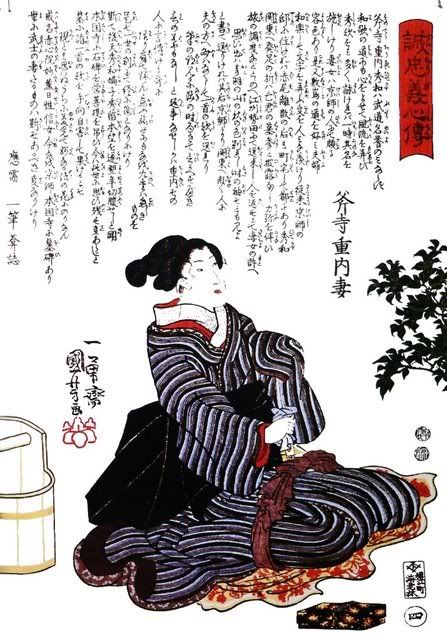
Benkei holding a halberd
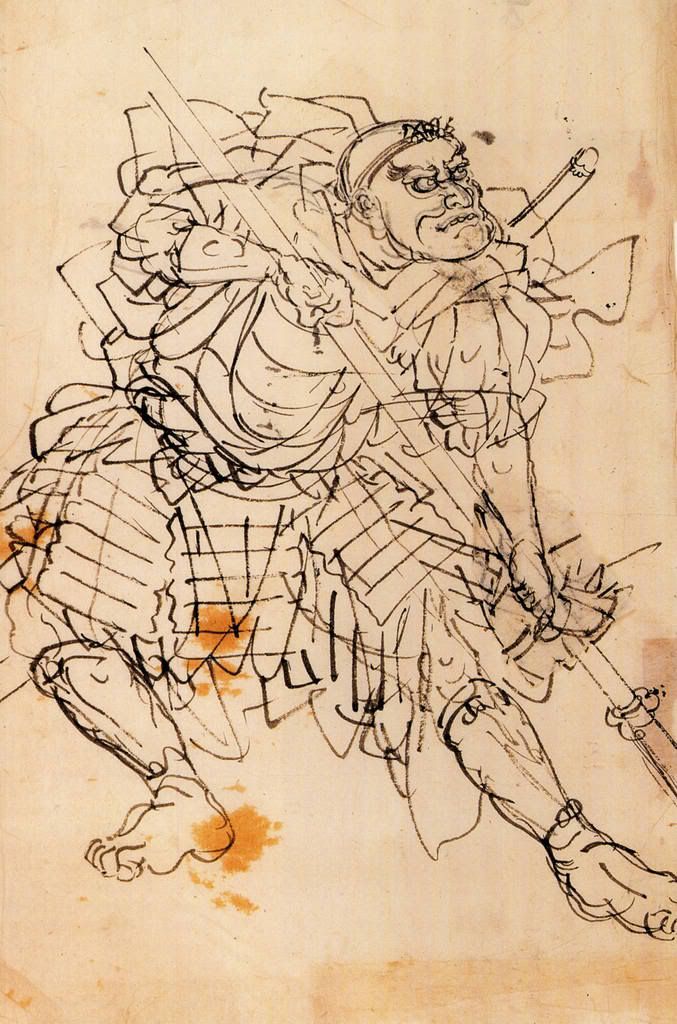
Tuesday, April 22, 2008
Kuniyoshi: Kanadehon Chushingura “a Japanese Kabuki production”
The following is taken from the website for “Degener Japanese Fine Prints”
From: http://www.degener.com/A_1057.htm
Kanadehon Chushingura “a Japanese Kabuki production”
Of the numerous dramas performed in the kabuki theater, by far the most popular as a subject for color prints was the Chushingura, or the "Loyal League of Forty-seven Ronin", mostly published in series of eleven or twelve designs corresponding to the eleven acts of the drama (with occasionally an additional design of one of the extra-scenes of act XI, like in the case of the set by Kuniyoshi represented in this section). The fact that the complete play was illustrated in an entire series of 'tableaux' gives us some idea of its immense popularity, a popularity which it has retained to the present day.
Originally written for the marionette theater by Chikamatsu Monzaemon (1653-1723) and Takeda Izumo (1688-1756),
The revenge-story of his faithful retainers who so had become masterless samurai, or ronin, is the subject of the play, here illustrated by Utagawa Kuniyoshi.
Reference:
Henk Herwig, "Heroes of the kabuki stage",
William Pearl's gradually expanding web site, exclusively devoted to the work of Kuniyoshi: Kuniyoshi Project
Please visit http://www.degener.com/A_1057.htm for all of the prints in this series
Act III:
Yenya's attack on Moronao, he is being restrained, while the latter falls.
Act IV: Hokan's Hara-kiri
Yuranosuke outside the castle by night, holding the dirk with which his lord had performed seppuku.
Act VII: Ichiriku Geisha House
The spy, Kudayu, dragged from under the flooring; Yuranosuke and O-Karu above.
Act VIII: The Bride on her Way
The bridal journey of Konami and her mother, Tonase; they rest under a tree, with
Act IX: The Quiet Retreat in Yamashina
Rikiya attacking Honzo with a spear, Yuranosuke in the doorway.
Act XI / scene 1: The Raid
The ronin in the snow surrounding Moronao, who has been dragged from the charcoal-
Act XI / scene 2: Moronao's head
Yuranosuke and the ronin laying the head of Moronao on their lord's tomb.
Kuniyoshi: Master of Musha-e
musha-e: "Warrior prints." as defined at http://www.osakaprints.com/content/information/glossary.htm
Musha-e: "Originally, paintings of historically important warriors; also includes warrior prints." as defined at http://ana.lcs.mit.edu/~jnc//prints/glossary.html
From Wikipedia:
"Kuniyoshi was an excellent teacher and had numerous pupils who continued his branch of the Utagawa school. Among the most notable were Yoshitoshi, Yoshitora, Yoshiiku, Yoshikazu, and Yoshifuji. Typically his students began an apprenticeship in which they worked primarily on musha-e in a style similar to that of their master. As they became established as independent artists, many went on to develop highly innovative styles of their own. His most important student was Yoshitoshi, who is now regarded as the "last master" of the Japanese woodblock print."
From http://www.kuniyoshiproject.com/Main%20-%20Characters.htm and http://www.kuniyoshiproject.com/Main%20-%20Warrior%20triptychs.htm
Kuniyoshi portrayed nearly 1,000 different characters in his warrior and historical prints.
Kuniyoshi produced more than 370 warrior triptychs and diptychs between 1818 and his death in 1861. This number does not include his many depictions of actors in historically based kabuki plays. ...the individual panels are each about 14 by 10 inches (36 by 25 centimeters), a size known as ôban.
Some musha-e prints:
"Hasebe Nobutsura during the taira attack on the takakura palace, Kyoto"
(click painting to purchase t-shirts with this quote)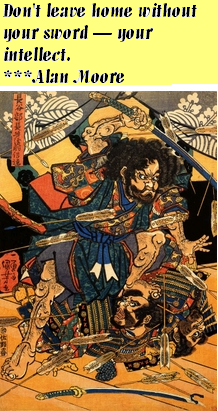
"Kagesue, Takatsuna and Shigetada crossing the Uji river"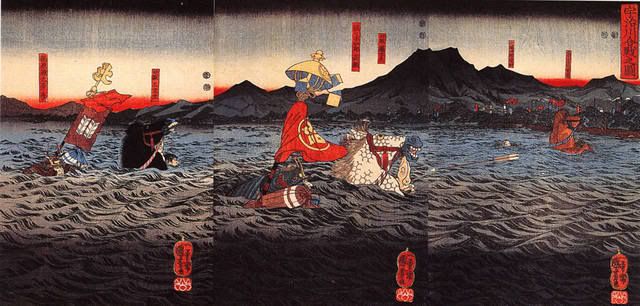
"Honjo Shigenaga parrying an exploding shell"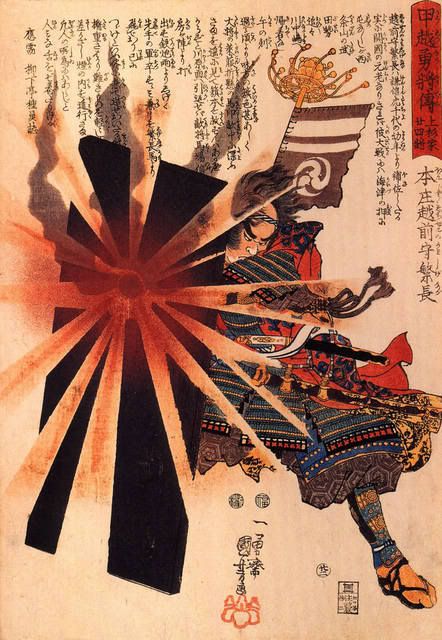
"Femme Samurai"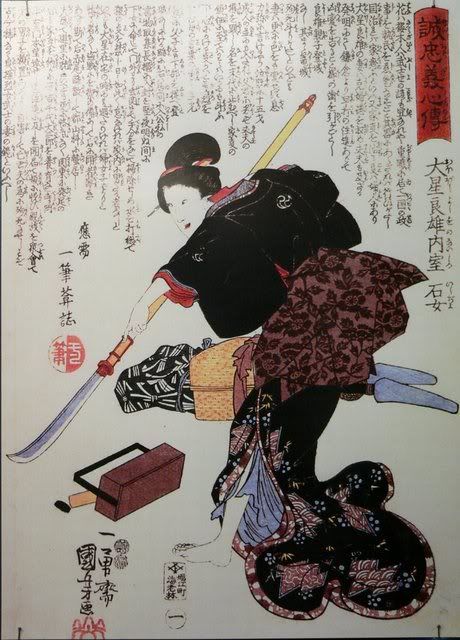
Thursday, March 13, 2008
Kuniyoshi: Similarities between Art and Reality
Ukiyo-e is known for it's renditions of the real 'secular' world. Here are some similarities between Kuniyoshi's prints and my world.
Cat and Goldfish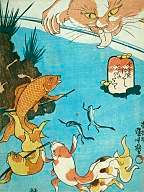
Gus and Aquarium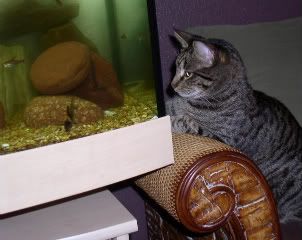
Woman with cat in background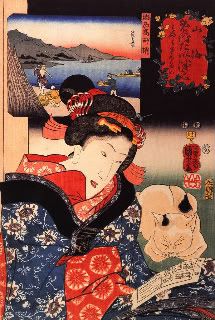
Similar composition but Gus is in the foreground
Saturday, March 8, 2008
Kuniyoshi: Outlaw Artist with commentary about the Edo period from Nagai Kafu
As previously discussed, Kuniyoshi had the true spirit of the 'Artist' and did not always conform to the ruling paradigm. He lived during a time of strict government that ruled all aspects of life. Below you will find excerpts from an interview with an author that lived about 100 years after Kuniyoshi, but had a lot of insight about the period.
Nagai Kafu (1879-1959)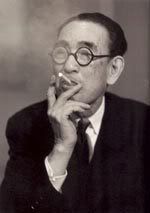
Excerpts from an Interview with the illustrious Japanese author Nagai Kafu (1879-1959)
"...
YR: No, I suppose not. In which case let us proceed to another ambiguity. You seem distinctly individualist in philosophical bent and general temperament, and yet you appear to hanker after the Edo period, which was probably even more authoritarian than the Meiji period and all that it ushered in.
NK: Well, this is true. But perhaps that is the fault of my fatalistic nature. I do not admire authoritarianism, by any means. But the problem is one of aesthetics. The arts of Edo, not to mention the architecture and the manners, were far superior to the arts of our ill-considered 20th century. [5] The thing about the tyranny of the past, I suppose, is that it has been an oppressive cloud casting a great shadow, and I’m sure you are aware how fond I am of shadows and what is to be found among them. The ukiyo-e, for instance, for which I harbour almost religious feeling, is just such a product of this tyrannical shadow, the art of the oppressed plebeian, expressing in part resignation and in part defiance. Please note it is not the tyranny, but the resistance to that tyranny with which I am in especial sympathy."
"...
YR: Yes, you’re quite right. Perhaps it is irrelevant. Speaking of which, do you think your work, backward looking even at the time of writing, has any relevance for readers today? Is it even healthy to be reading something that dwells so much on a past irrecoverably lost?
NK: My immediate response is to say that I do not care whether it is relevant to ‘the reader of today,’ or not. I have had occasion to wander the streets of Asakusa, Mukojima, where I set Bokuto Kidan, Fukagawa, Nihombashi – I could go on – and I find that as the city approaches the 21st century, there remains not a shadow of the city I knew and wrote about. I cannot hope to describe the overwhelming sadness that the sight of the modern streets induces in me. There is the sense of a world lost as in the blinking of an eye, and I come to feel the true meaning of what it is to be a ghost. ‘As I witness the extinction of the city’s spirit I feel in all my being nothing but a desire to be gone with it.’ [10] You ask if my works are relevant today, but that is not for me to answer. Why trouble my ghost with these questions? Perhaps it is best to be forgotten, to be perfected by obsolescence, to rest, rather than be called back and called back like this to a present where one does not belong. Let the past be the past and the present be the present. Only one thing – perhaps you should ask yourself why you wished to ask me such a question. I have passed on and such matters do not concern me, but the living are necessarily more restless than the dead. It is the living, perhaps, who are more haunted by the past.
YR: Have you anything to say before you slip once more through the ghostly turnstile to the other side?
NK: Yes. Your last question has set me to thinking. If I might be allowed to quote myself, and whether you act on it or not it is a truth, “I say it unconditionally: Our future has no road to proceed from save that of our past.” [11]
YR: Nagai Kafu, thank you very much for your time.
NK: Thank you.
And somewhat like a Cheshire Cat, Kafu fades away, leaving behind his spectacles and his gap-toothed grin for a moment. "
Directory of Lost Causes (By Quentin S. Crisp)
Shown Below:
A giga print called Ue-shita-e. These designs can be viewed upside down. Depicts various faces including a frog; tengu; the great general Zhanghi in the Three Kingdoms, and the tyrant King Zhou of the Yin Dynasty. Published by Ezakiya Tatsuzo, c 1842. Another impression ( from the Museum of Paper, and attributed to Kuniyoshi ) is illustrated in Edo no Asobi-e, no.2 and back cover. Rare.
upside down: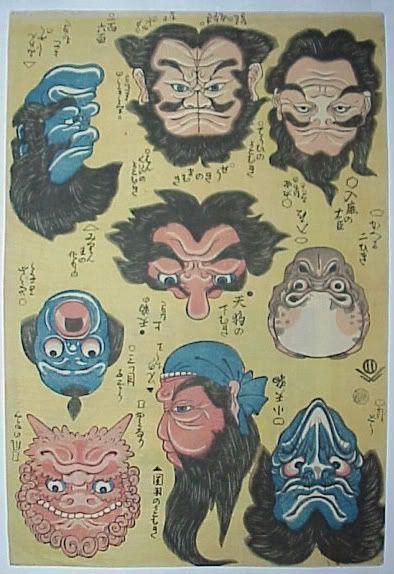
Tuesday, February 26, 2008
Kuniyoshi: Versatile, Whimsical, Comical
Utagawa Kuniyoshi (1798-1861)
Print from the series 'Graffiti on a Storehouse Wall'1847
Nishiki-e (brocade print)
Ôban size
Signature: Ichiyûsai Kuniyoshi ga
Publisher: Ibaya Senzaburô
Censorship seals: Kinugasa and Hama
Kuniyoshi was an extremely versatile artist and was known to have studied techniques from a variety of different schools. The influence of Western-style line drawing is evident in the fluid, impromptu lines of these amusing caricatures of popular Kabuki actors.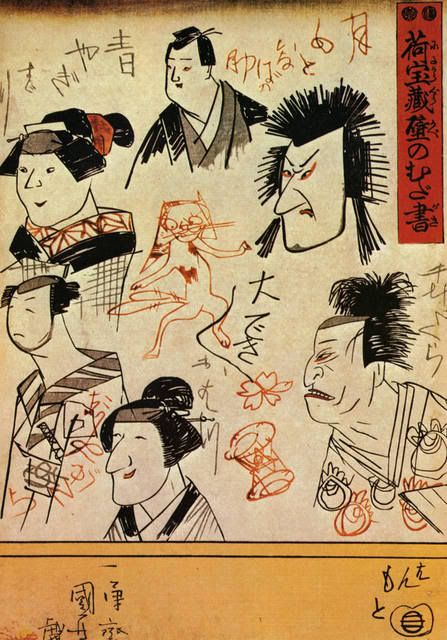
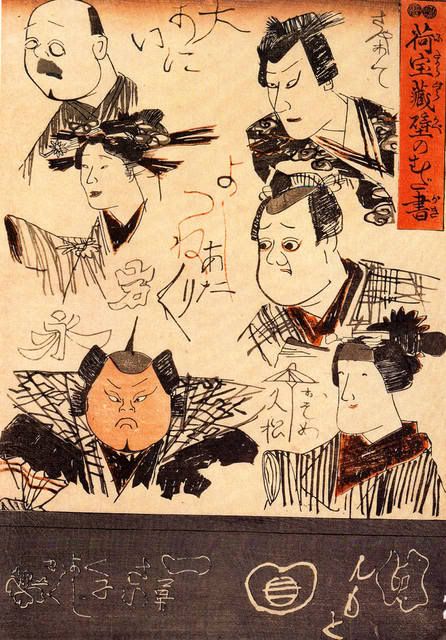
Monday, February 25, 2008
Kuniyoshi: Outlaw Artist Spirit
From:
http://www.viewingjapaneseprints.net/texts/ukiyoetexts/ukiyoe_pages/kuniyoshi3.html
When the Tenpô reforms of 1842 banned prints of beautiful women and kabuki actors, prints depicting warriors and legends became the life-blood of artists like Kuniyoshi. As a result he issued several large series of warrior prints in the 1840s. Yet even historical subjects could prove dangerous if treated in the wrong manner. In 1843, when Kuniyoshi designed a very popular satirical triptych of the shogun Tokugawa Ieyoshi and the earth spider, the woodblocks and remaining stocks of unsold prints were confiscated and destroyed, and Kuniyoshi was investigated and officially reprimanded.
The illustration shown here is from one of the series issued while the Tenpô Reforms were still casting a shadow over print production. Titled and shown below, Genji kumo ukiyo-e awase ("A Comparison of Prints of the Floating World with the Cloudy Chapters of Genji"), it was published by Iseya Ichibei circa 1845-46. The series is apparently complete in 60 known designs, 54 for each chapter in the Genji monogatari ("Tale of Genji") plus 6 supplemental designs. The current design is number 31 (indicated in the lower left margin) corresponding to the Makibashira ("The Cypress Pillar") chapter, with its title shown in the middle of the scroll above, and the series title appearing at the top right on the scroll cover. The Genji-kô (Genji incense emblem) for chapter 31 is shown as a repeated pattern on the scroll surrounded by a poem. A descriptive text by Hanagasa Karitsu appears below the scroll at the far left.
After the great victory on April 25, 1185 at Danoura in which Minamoto no Yoritomo and his half brother Yoshitsune defeated the Taira clan, Yoritomo, who would be designated as the first shogun of Japan, became unjustly suspicious and jealous of the brilliant military exploits of his younger brother. He refused to allow Yoshitsune entry into the headquarters in Kamakura, and instead sent him off to Horikawa in Kyoto. Yoritomo then secretly dispatched a warrior monk named Tosabô Shôshun to assassinate Yoshitsune. The attackers were defeated and Shôshun was captured and beheaded by the legendary Benkei, the warrior priest and ally of Yoshitsune. From then on Yoshitsune took flight from his murderous brother, only to be ultimately forced to commit 'seppuku' (ritual suicide) rather than be captured in a final battle at Koromogawa on May 16, 1189.
The scene in Kuniyoshi's print depicts Kurô Hangan Yoshitsune as he grasps a pillar on the balcony of the palace at Horikawa. This gesture represents an obvious pictorial pun on the cypress pillar of the Genji chapter. It also connects Yoshitsune with the metaphorical meaning of "big size" used commonly in traditional Japanese poetry for the title word 'makibashira'. At the far middle left there are military banners rising through the mist, which belong to Tosabô Shôshun and his warriors. The heroic figure of Yoshitsune standing on the railing and defiantly observing his attackers while arrows strike all around him makes this one of the more successful designs from the series. ©1999-2001 by John Fiorillo
Friday, February 22, 2008
Kuniyoshi: Nue, Legendary Creature of Misfortune
A nue (鵺) is a legendary creature found in Japanese folklore. It is described as having the head of a monkey, the body of a raccoon dog, the legs of a tiger, and a snake instead of a tail. According to the legend, nue can transform into a black cloud and fly. Due to its appearance, it is sometimes referred to as a Japanese chimera. Nue are supposed to be bringers of misfortune and illness.
According to The Tale of the Heike, Emperor Konoe, the Emperor of Japan, became sick after having terrible nightmares every night, and a dark cloud appeared at two o'clock in the morning on roof of the palace in Kyoto during the summer of 1153. The story says that the samurai Minamoto no Yorimasa staked-out the roof one night and fired an arrow into the cloud, out of which fell a dead nue. Yorimasu then supposedly sank the body in the Sea of Japan. In a local expansion of the story, the nue's corpse floated into a certain bay, and the locals, fearing a curse, buried it. A mound which exists today is supposed to be this grave.
Etymology
Nue as a word appears in the oldest of Japanese literature. Early quotes include Kojiki (712) and Wamyō Ruijushō (c. 934). Due to the usage of Man'yōgana, the historical spelling is known to have been nuye. At this early time, though, it had a different semantic meaning. It referred to a bird known as White's Thrush.
In the 13th century, Heike Monogatari makes reference to a creature called a nue. In addition to having the head of a monkey, the body of a tanuki, the paws of a tiger, and the tail of a snake, it has the voice of a White's Thrush.
Around 1435, Zeami wrote a Noh song titled Nue dealing with the events described in Heike.
Shown Below:
Taiba (The End), 1852. 9.5" by 14.25". The print depicts a Nue descending upon the Imperial palace in a black cloud.
Thursday, February 21, 2008
Ukiyo-e - The Art of Japanese Printing
A Good Description From: http://www.ancientmuseumstore.com/Samurai_in_Attack_Utagawa_Kuniyoshi_p/ku04.htm
The world portrayed by the art of Japanese printing can be captured under one romantic, by origin Buddhist, name - ukiyo-e, or the floating world. It's a world of brief amusement and pleasure - of daily life like it took place between the 17th and 19th century in theatres, on the street and during parties and festivals. Before the ukiyo-e period Japanese art was mainly about images which pleased the Japanese feudal lords - grand, colorful and elegant works of art which portrayed courtly life, made by artists who belonged to the traditional Kano and Tosa school. Little could be seen of daily life of the Japanese people. Every now and then one could catch a glimpse of the forthcoming ukiyo-e period which would portray common life in all its glory, with a leading part put aside for actors and courtesans. This changed when ukiyo-e made its entrance. After a turbulent period of political turmoil, the Tokugawa period commenced - a period which would herald a strict, dictatorial regime by the so-called Shoguns, who belonged to the Tokugawa family.
To control the population, social life was restricted and entertainment for the common Japanese was limited to parties and festivals. The artists belonging to the traditional schools like the Kano and Tosa school adapted to this new era and woodblock prints emerged presenting every day life. Soon these woodblock prints became very popular and the Tokugawa period counts as a milestone for the art of Japanese printing. Initially a print was a cheap derivative of the traditional art of painting. Due to advancing woodblock print techniques the art of wood block prints developed into a full and popular art form during the 18th century. To make a woodblock print the artist worked closely together with various craftsmen. He drew his design on a translucent piece of paper, the hanshita-e. The paper was dampened and carefully traced by the copyist onto a plate of cherry wood. The engraver carefully carved out the fine graved cherry wood, along the lines of the design, removing everything but the design lines. He could not afford to make a simple mistake, because it was irretrievable. However, his work was more than purely that of a craftsman. He was expected to revise the sometimes rough sketch of the artist into fine, fluent lines in relief in the wood. Then the artist indicated which planes should get which color and a plate was cut per color. The printer prepared and cut special paper which was made from fiber of the mulberry tree. He first printed the color planes and then meticulously the line drawing. For the paint he used materials of vegetable origin.When we look at the wood block prints now we should realize that many of the original colors have faded over the years. The publisher was the organizational and commercial keyman during the process. He gave the artist the assignment and paid the craftsmen. Sometimes the prints were put onto the market by the thousands. Because of this they became affordable, which obviously contributed to their large popularity. With this in mind it seems unjust that for a long time only the name of the artist, sometimes the name of the engraver and only seldom the publisher, was mentioned on the print.
Shown Below:
Hattara Sonja with his white tiger: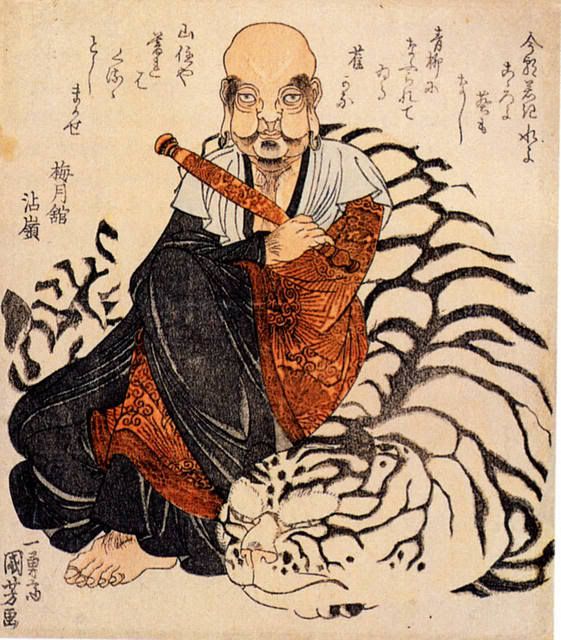
Wednesday, February 20, 2008
Utagawa Kuniyoshi - The Kuniyoshi Cat Inaguration
This blog will be dedicated to the art and influence of Utagawa Kuniyoshi.
The following is an excerpt from http://www.kuniyoshiproject.com/
The man who was to be known to history as Utagawa Kuniyoshi was born in Edo (present-day Tokyo) in 1797. He was the son of a silk dyer named Yanagiya Kichiemon and was given the name Yoshisaburô. At the age of 14, Yoshisaburô joined the Utagawa School of ukiyo-e artists, then headed by Utagawa Toyokuni I (1769 - 1825). Toyokuni I gave Yoshisaburô the name Utagawa Kuniyoshi, Kuniyoshi being a combination of Toyokuni and Yoshisaburô.
In 1814, Kuniyoshi ended his apprenticeship and set out as an independent artist. He initially produced actor prints in the style of his teacher, which gained him little recognition. Kuniyoshi achieved a commercial and artistic breakthrough in 1827 with the first six designs of the series, The 108 Heroes of the Suikoden. The series was bases upon a 14th century Chinese novel about the adventures of a band of 108 honorable bandits and rebels.
Like his teacher, Kuniyoshi had many students including Yoshitoshi, Yoshi’iku, Yoshikazu, Yoshitsuya, Yoshiyuki, Yoshifuji, Yoshifusa, Yoshiharu, Yoshikage, Yoshikata, Yoshikatsu, Yoshimori, Yoshimune, Yoshinao*, Yoshinobu*, Yoshitoyo*, Yoshitsuna, Kyôsai (briefly) and his own daughters, Yoshitora and Yoshitori. Kuniyoshi had a special fondness for cats, which overran his studio and are portrayed in many of his prints.
Although Kuniyoshi is now universally known as Utagawa Kuniyoshi, he also used the names Ichiyûsai Kuniyoshi, Chô-ô-rô Kuniyoshi, Igusa Kuniyoshi, Ichi Kuniyoshi and Saihôsa Kuniyoshi. He died from complications of a stroke on April 14, 1861.
____________
*These names were used by print artists in the city of Ôsaka as well as by the Edo artists who studied with Kuniyoshi.
Shown below:
Title: Umegae mugen no mane (Japanese) *not dated
Description: A parody (mitate) of a scene in the fourth act of the kabuki play, Simple Chronicle of the Fortunes of the Heike and Genji (Hiragana seisuiki). In the play, Genta Kagesue strikes a stone water basin and is showered with gold coins, which are thrown by his concealed mother.
